In November 2016 I attended a “How to Water and Plant Native Plants” seminar at Rancho Santa Ana Botanic Garden. Andrew Chambers, who works with RSABG’s Nursery and Conservation programs, shared what he’s learned from experience and discussions with other native plant experts. He also demonstrated RSABG’s recommended planting technique (see photo gallery below).
You will find native plant nursery websites and experts have instructions that vary some, but here are recommendations (I’ve bolded what I think are most important) and why they’re important.
- Don’t amend the soil. Instead, if you have really clay soil or very sandy soil, it’s better to talk to nursery experts about the plants that will do well in your type of soil.
- Dig a hole twice as wide and one and one-half times the depth of the container. (Why? so there’s room for your hands to compact the soil, and you can add soil to the right depth vs taking the plant in and out while digging the correct depth.) Water the plant in the container so it’s well irrigated when you plant it.
- Water the hole twice (once minimum), letting it drain. If you have heavy clay soil, this could take a couple hours.
- Do NOT rough up roots at all – because native plant roots are very sensitive – you want to handle the plant and roots as little as possible. If rootbound, Chambers said to squeeze the roots some to help break them up.
- It’s important to place the plant so the top (and most importantly, the main stem) sits 1/2 inch to 1 inch above the soil. (Why? This prevents root rot. Also, if the stem gets buried it can’t ‘breathe’ and will get girdled, killing the plant.) Use your shovel to to estimate the depth before taking the plant out of the container. Add soil to the needed depth, using your hands to compact it.
- After placing the plant in the hole, fill with soil to a halfway point, compacting it with your hands so air pockets are removed. (Why? Roots really dislike air pockets and will die in the area of the air pockets.)
- Water the plant up to the top of the basin, and let it percolate. (This settles the filled dirt, reduces air pockets, and homogenizes the area – meaning the soil in the container mixes with the native soil.)
- Then fill in the rest with soil – not amended of course – and build a substantial basin for watering (Why? You want the roots to expand outwards and downwards.)
- Then water a lot – like 5-10 gallons!
“Fill your newly created berms with water numerous times, and your new additions will thank you days, weeks, months, and years down the road.” – Andrew Chambers, RSABG
Why this works?
He referred to Bob Perry, author of Landscape Plants for California Gardens, who in November 2014 planted 1500 plants in a hot inland city, Hemet CA, did the above technique, and didn’t water for 6 months — and only six died! Watering heavily allows the entire area to get soaked, prompting the plant to send roots down and out to retrieve that water.
Photo Gallery of the Process
So how much to water after planting?
The above is the easiest part of the instructions – and will increase survivability greatly. If you plant in the fall and water 5+ gallons at planting, you can let the rainfall in a normal winter suffice. Give supplemental water if there’s no rain, making sure the plant is dry when you scratch down into the dirt.
As for watering in our dry months, Chambers said it really depends on the plant type. If it’s a coastal plant, it needs more water; if it’s a Eastern Sierra plant or desert plant, or an inland native like a Big Berry Manzanita or Nevin’s Barbery in our Inland Empire, water less.
There’s also factors like your soil type (clay holding more water than loam and especially sandy soils), and temperature. Chambers gave examples of once to twice a month in the summer and fall for coastal plants, to once a month or every other month for desert, inland, or Eastern Sierras plants.
A few other tips I thought were interesting:
- How long a plant can stay in a container? It depends… Chambers said grasses are hardy and will last a long while, while plant trees asap. Others – 3 weeks to a month, especially if you bought them in a hot spell.
- How often to water it in the container? In hot weather, water a 1 gallon plant three times a week, once a week if cool should be okay.
- Signs a plant needs water – A plant’s shiny leaves will dull, followed by wilting the next day – so water!
- Wash off dust – “Most native plants dislike dust, so rinse them off every three months or so,” says Chambers.
- Spray vs drip? The ongoing question…. Both have advantages – drip is less wasteful and gets water directly to the roots, while spray provides overhead dust removal. If you’re putting in a new irrigation system, Chambers recommends mp rotators because it’s a combo of the spray and drip. Landscape designer April Garbat likes Netaphim drip irrigation, which is a grid of tubing placed above the soil and under the mulch that is great for infrequent but slow irrigation.
- Mulch? Not always, and never right up against the stem. Replicate what is in nature; for ex, coastal or woodland plants have mulch but chaparral does not, and desert plants prefer fine rocks/gravel. All natives like rocks near them, which helps keep their roots cooler.
- Potting soil breaks down an inch over a year’s period – which is another reason to avoid using it with natives.
Happy Planting!
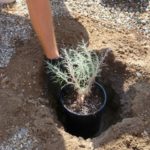
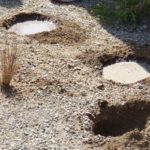

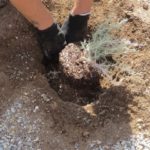
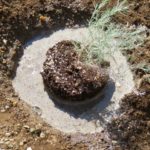
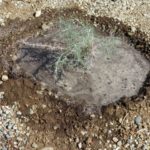
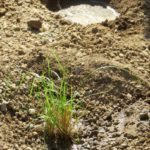
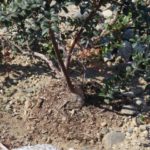
Leave a Reply